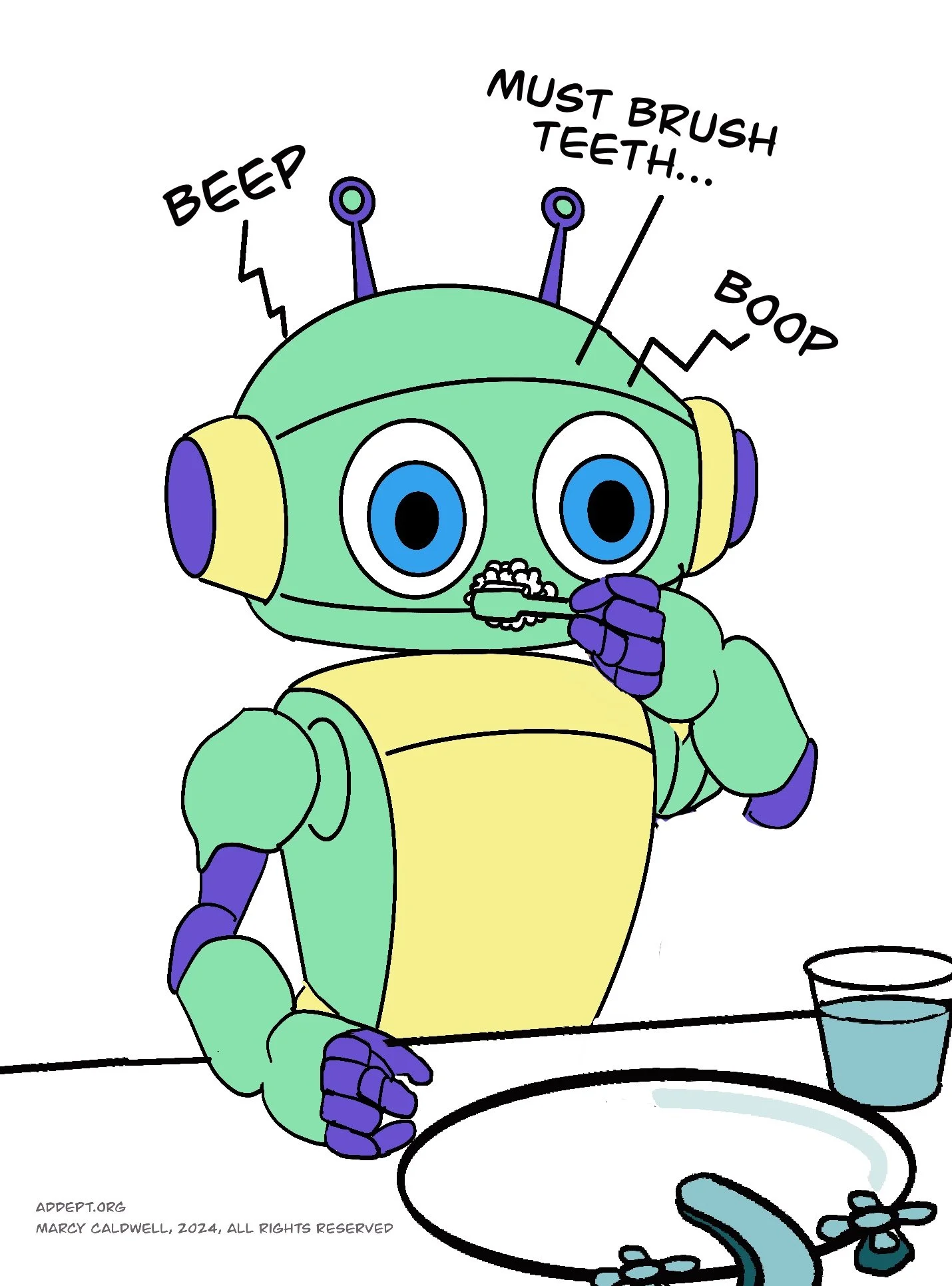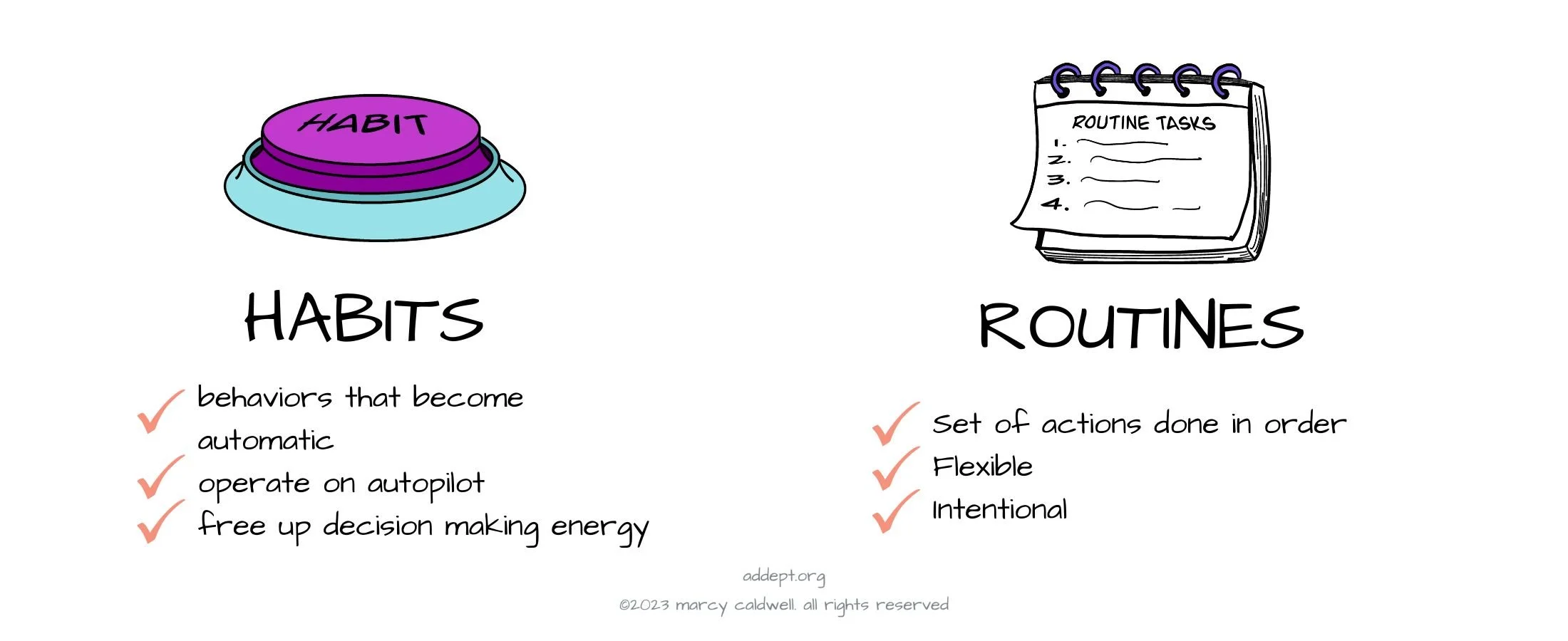ADHD-friendly Routines:
Why they Unlock our Success and How to Craft the Best Ones for You
Does the mere word “routine” sound like both a panacea for all that feels wild and crazy in your life and also fill your soul with angst and dread?
Oh, you are so not alone.
Because the ADHD brain thrives on novelty and stimulation, the concept of routines can seem like both an impossible dream and a horrifying possibility. But routines—when crafted with your unique ADHD brain in mind—can actually be a secret weapon, providing stability and creating a sense of control to reduce stressful moments.
ADHD and Routines
If you have an ADHD brain to call your own, you know that sticking to a routine can be one of the hardest challenges of all. When your brain is set to constantly crave new and stimulating experiences, doing something (or a set of things) in the same way over and over can feel not just restrictive but downright dull.
But there's good news! Routines don't have to be boring or limiting. They can be designed to fit the ADHD brain's need for variety while still providing structure. The key is to find the right balance.
Think of routines as a jazz improv sesh rather than your childhood scales practice. Your daily schedule doesn’t have to be the same note being played over and over (yawn). It can be more of a flexible structure that allows for spontaneous solos.
How does that work?!? You ask. I’m so glad you did.
Here’s an example:
Well, let’s just say you want to create a morning routine—something to set the day off in a way that assures all your needs are taken care of. Fantastic! Sounds like a wonderful idea. But how do you actually get that done?
Here’s what’s not going to work:
Well, rather than creating it in a way that makes you turn into a little productivity robot- mindlessly moving from one task to the next the same way each and every time (beep…boop…must brush teeth…beep….now wash face…).
The more ADHD-friendly alternative:
An ADHD-friendly routine leaves room for you to add your own personal sparkle by switching up the details
—today’s workout could be a brisk walk in the park, while tomorrow’s might be a dance-off in the living room.
— Or you might drink your morning coffee on the porch in a rainstorm today and cuddle in front of the fire tomorrow.
With some creativity and thought, your routines become more like friendly guiding prompts instead of carved-in-stone edicts.
The difference between habits and routines
Mixing up routines and habits is like mistaking a cat for a tiger— upon first glance, they look pretty darn similar, but in reality, one's a domestic fuzzball, and the other might eat you for breakfast (ok- maybe that’s not the best example- both habits and routines are more likely to get you fed for breakfast than eat you for breakfast)
Routines
Routines are a series of planned activities done in a specific order, often at a set time. Take a morning routine, for example, waking up, brushing your teeth, showering, and having breakfast. Each action is purposeful and tends to happen in order, making it easier for you to navigate your day knowing that the key things will happen.
While routines don’t happen on autopilot, like Habits, their benefit lies in their flexibility and intentionality. You can decide today that you want to start a new routine tomorrow, and with some planning– Voila! Routine started! Also, because routines are intentional, they allow for the sprinkling of variety and ADHD sparkle that I discussed above- letting you sub in one activity for another while keeping the same basic structure.
Habits
Habits, on the other hand, are behaviors that become automatic over time through repetition. They stem from consistent practice and often don't require conscious thought. For instance, tying your shoes or reaching for your phone when you hear a notification are habits that have been ingrained through frequent repetition. Unlike routines, which are designed and intentional, habits often operate almost on autopilot.
The beauty of habits lies in their efficiency. For our ADHD brains, provide a framework where actions can be performed without the heavy lifting of decision-making. When a behavior transitions into a habit, it frees up cognitive resources, allowing for better focus on tasks that require more attention.
The benefits of routines for ADHD brains
1. Reducing executive function meltdown
Ah, executive function—the brain’s circus juggler: balancing the all-important tasks of planning, focusing, prioritizing, and more all at once!
For an ADHD brain, these tasks can feel more like a never-ending, positively exhausting game of Whac-A-Mole.
Enter routines, the trusty sidekick swooping in to save the day! By creating a reliable pattern, routines lighten the mental load, freeing up precious brainpower for other fun activities (like trying to remember where we left our keys… again). Instead of burning energy pondering when to tackle the vacuum or fit in that Zumba class, a solid routine swoops in to do the thinking for us!
2. Beating decision fatigue
We all wake up everyday to face days positively bursting with decisions.
What to wear?
What to eat?
Should I work out?
What friends should I call?
Each choice can feel like a mini-marathon, especially for an ADHD brain, leading to something we fondly refer to as decision fatigue. Routines simplifying our daily choices, and routines cut down the decision-making workload, helping us glide through the day with more pep in our step and less “Ugh, what should I do now?” spiraling.
3. Mastering task completion
If you’ve ever started something with the best intentions only to have it slip your mind like a bar of soap, you’re in good company!
Routines work like a trusty checklist that gently nudges us to prioritize tasks and ensure those crucial items don’t get lost in the shuffle. Whether it’s remembering to take our meds or finishing that work project, we promise we’ll get to it eventually; routines help us stay on track.
Evening stretching session? ✔️ You bet we’re mastering that! Routines aren’t just helpful; they can become our superpower in turning “I forgot” into “Got it done!”
How to create effective routines
1. Set up morning and evening routines
Start with the basics: morning and evening routines. These are critical times when having a set pattern can make a huge difference. Mornings can include activities like exercise and planning the day, as well as any extras like journaling or mindfulness practices. Evenings might focus on winding down activities such as listening to soothing music or having a long bath.
Want a step-by-step guide for crafting an ADHD-friendly morning routine? Check out our free downloadable system here.
2. Write it all down
Write down all the tasks that need to be included in the routine. Think through the best order to complete them and then outline this clearly, adding times. Post this schedule in prominent spots like the refrigerator or workspace to keep it visible and easy to access.
3. Set up adaptable routines
Life isn't always predictable, and that's okay. For those with varying schedules, consider creating A/B routines that differ according to daily commitments. This might take longer to set up but it also allows for flexibility while still maintaining structure.
4. Include reminders and alarms
Using reminders and alarms can be a game-changer. Set alerts on phones or use physical timers to signal the start and end of routine activities. This helps keep track of things and confirms tasks are completed without drifting off course into a reverie or a three-hour YouTube binge.
5. Make it fun
Routines don’t have to feel serious and virtuous—instead, spice things up with fun elements. Play music during activities or create small rewards for completing tasks. Loaded the dishwasher? Great, now it’s time for a double chocolate chip cookie. Pleasure and rewards increase the likelihood of sticking to a routine.
6. Start small and build gradually
Creating a routine doesn’t have to be overwhelming—start with a few simple tasks and gradually add more as they become habitual. This approach makes it easier to adapt and stick to the routine over time.
7. Account for downtime
No one is a robot (beep-beep), so don’t fall into the trap of stacking a day up with so many tasks that there are no breaks. After all, moments of relaxation are essential for recharging and preventing burnout.
8. Prioritize flexibility
Life changes and so do circumstances, so be open to adjusting routines as needed. Flexibility helps routines remain relevant and effective, allowing for adaptations without feeling like a failure. Remember—a routine isn’t an army drill, it’s an aid to living a complex and changeable life to the fullest. So avoid any Full Metal Jacket vibes.
9. Use visual aids
Visual aids such as checklists and calendars can help keep routines on track. This provides a clear, tangible way to see what needs to be done and also offers a sense of accomplishment as tasks are checked off. Don’t be afraid to make visual aids colorful and fun—invest in DayGlo Post-its and glitter pens, if that works.
10. Find accountability partners
Body doubling is a powerful ADHD hack and can either mean performing a task with another person, or just having a cheerleading accountability partner. So aim to share routines with loved ones or ADHD support groups. Having someone to check in with can offer motivation and camaraderie, making it easier to stick to the routine.
11. Evaluate and adjust regularly
It’s okay to switch up routines, so take time to evaluate how it’s all going. Is more downtime essential? Should fewer tasks be packed into one day? Make adjustments as needed to improve effectiveness and ensure routines meet changing goals.
12. Celebrate successes
Don’t forget to celebrate small wins. If a routine has been followed for a week or even a day, maybe a treat or a self-cheer is in order. Positive reinforcement boosts motivation and underlines the benefits of sticking to routines, making it easier to stay on the train.
ADHD and routines? They can be the best of friends
Routines may seem daunting for an ADHD brain that loves novelty and spontaneity, but they can be incredibly empowering. By reducing the mental load (including decision fatigue) and making sure crucial tasks get done, routines offer stability and control and are key to that all-fabulous feeling of “I’ve got this!”.
With a little planning and flexibility, routines can be tailored to fit your life and your brain.
Join the conversation
How do you feel about routines? Which ones have worked well for you? Share your experiences with us in the comments below!
Ready to shift from
meltdown to mastery?
This online course has been designed specifically to help teach the strategies ADHD brains need to help them move from overwhelm and meltdowns to confident emotional mastery.










How to Beat the Winter Blues: Tips for ADHD and Seasonal Affective Disorder